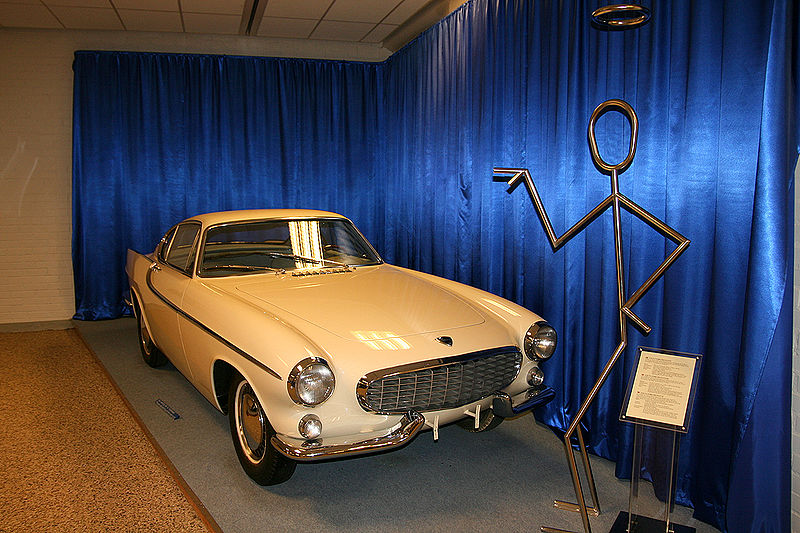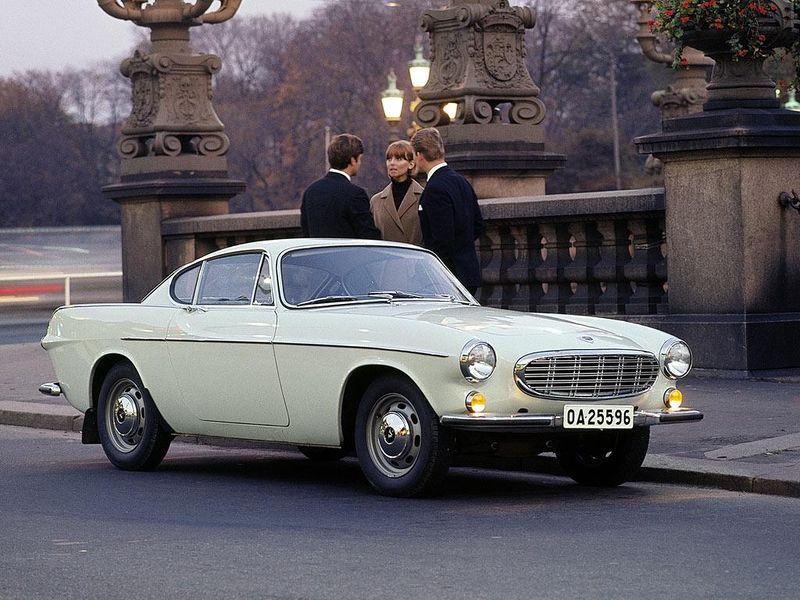
Filed Under: News

When one reads a car company brochure, one would expect it to be reasonably correct, for years most people believed the P1800 Volvo was the work of an Italian Design Studio, however it is creeping out that Volvo did not exactly tell the truth, in 2009 they admitted that the P1800 was designed independently by Pelle Petterson who worked at the design studio, but his father was Helmer Petterson who was a technical consultant with Volvo, he knew about Pelle’s design and that Volvo going to Frua for a design, they may have chosen one not done by his son, naturally he did not let the Volvo management know of his involvement, luckily the company chose Pelle’s design and then he let the company know who had designed the new car, needless to say the president of Volvo was not pleased but apparently the design was such he was not going to change his mind.
Volvo did not have the capacity to build the car and looked for a builder, they tried to get Kharman to build the 1800, whilst there was great interest, the story gets even worse in that Kharman the German Car stylists and manufacturers were very interested in building the P1800, but Volkswagen who Kharman also worked for said that if Kharman built the Volvo they would take all their work from them.
This left Volvo with a situation that almost put an end to the project, luckily or unluckily Jensen motors of West Bromwich had spare capacity and contracted to build 10,000 P1800’s.
One has to remember that Volvo purchased a vast amount of parts from UK manufacturers, so to a degree it made sense the arrangement, the bodies were made by Pressed steel company in Scotland and shipped down to West Bromwich by train.
Volvo had been in talks with several other German firms and decided that their quality control was not up to Volvo standards, having said that Volvo took the contract away from Jensen after only 6000 cars had been made, due to quality control problems at West Bromwich, it has been muted that Volvo even put in one of their own quality control team, in fact they put a whole team in to try and sort the problem, it is said they took some cars back to Sweden and took them to pieces to try and sort the problem, but to no avail, production was switched to the Volvo facility at Gothenburg. Given that the 1800 started life in the late 1950’s it has taken a long time for the story to become public knowledge.
There is yet another story circulating that cars being shipped back to Sweden were placed in wooden crates on a freighter leaving Tilbury, also in the cargo was iron pipes and Whiskey, for an unknown reason and it is difficult to understand why
the freighter got into difficulties in the Thames and took on water which would of course be sea water, it was eventually abandoned, luckily no cars were swept overboard but they did suffer from water damage and it is said Whiskey fumes.
The freighter was recovered and Volvo decided to send the cars back to Jensen for rebuilding, according to information they were completely taken to pieces and rebuilt as new cars, with apparently new chassis numbers.
Whilst on this story the original test pre-production cars were sold off to staff with a stipulation that they could not be sold for at least one year, this was the only time this happened as it seems after that all pre-production cars were burnt and then crushed, which seems very severe.
Who would have thought a television series would make a difference to the sales of a car, When the ITV company decided to make the Leslie Chateris Saint series they needed a particular car to match the glamorous character.
Volvo were very lucky in the first place as originally it was anticipated that the E-Type Jaguar would be the “Saints” mode of travel, but Jaguar decided they did not need the publicity as sales were doing so well, Volvo gained an immediate lift and the P1800 will forever be known as the “Saints” car, he never changed cars for the series., though in one episode he was driving a Bentley.
Volvo provided two complete cars and a third car which was cut in half for filming purposes, it is said that Roger Moore was so taken with the P1800 he actually had one of his own. Apparently Volvo charged the ITV company the full price for the first car.
Now there is a further mystery, one of the cars NUV648E was sold for 50,000 sterling, one other car 77GYL is in a museum in Keswick Cumbria, cars for the stars, never heard of it but if you are in the north of England and fancy finding out more it would be appreciated, now there was two other cars involved 71 DXC and sister car to the other NUV NUV647E both have gone missing, no one can track them down, it seems they could be worth more than a few Euro’s, normally the DVLA can track cars down but not these two, could they have come to Ireland?
Technically one would expect the P1800 to have the same running gear as the popular Amazon, though it was an 1800 it had an engine developed from the B36 V8 truck engine which gave a massive five bearing crankshaft, now this came from an article and I can find nothing to confirm this, I therefore think it incorrect and that the P1800 had the same engine as the 1800 Amazon, this was mated to a newly developed M40 gearbox. Though the B18 always had a five bearing crankshaft, the previous B16 which was used for the original Amazon was a three bearing unit, so I am not happy with the info.
According to the specification the running gear was totally Volvo Amazon and even down to the brake set up.
The first P1800 appeared in May 1961, it was not actually built as a fast car but having said that it had sufficient power to run as the pace car in the Sebring 24 hour race held in florida.
 When the contract was taken away from Jensen the Swedish built model had an S added to the P1800 so that everyone was aware it was a Swedish built model, it came in four colours Red, White, Blue and Dark Grey, it is said that some of the first Swedish built models carried small Swedish flags, there is yet another little tale that the original cars supplied to the TV company were sparkling white, however when the 1800 came out of Gothenburg, Volvo had changed the white to a more creamy colour white. However the series was in Black and White so it did not make that much difference, I must have been too young to remember.
When the contract was taken away from Jensen the Swedish built model had an S added to the P1800 so that everyone was aware it was a Swedish built model, it came in four colours Red, White, Blue and Dark Grey, it is said that some of the first Swedish built models carried small Swedish flags, there is yet another little tale that the original cars supplied to the TV company were sparkling white, however when the 1800 came out of Gothenburg, Volvo had changed the white to a more creamy colour white. However the series was in Black and White so it did not make that much difference, I must have been too young to remember.
Back to the tech’s the B18 was a two carb SU unit, by the way the B stands for Petrol, the Swedish version also gained an extra 8bhp, just in case you are wondering about the running gear the Volvo had coil springs back and front with Mcpherson struts, at the back there is a panhard rod.
1969/70 saw some changes, 4 wheel disc brakes plus dual circuit braking a 1986cc engine designated the B20 and Bosch Jetronic fuel injection. The 1800 had a drum parking brake.
By this time the body was looking somewhat dated to those who must see new bodies, Volvo had a trick up their sleeves they changed the back end and put in an all glass tailgate making the Volvo sport a Volvo station wagon with an ES added to the P1800, this was 1972, production ended in June 1973 about 8000 of this fantastic and futuristic looking model were made, it is said they are in great demand and carry a premium price.
In the USA there is a P1800 which by now has covered 3million miles on the original engine and running gear, it has of course used tyres and all the other bits that one discards at the routine service, it is believed that it will be in the Guinness Book of Records. Volvo received some compliments regarding it’s engine one commentator described it has probably one of the finest engines developed.
The new C30 has a similar rear glass tailgate, what started as a simple story suddenly included mystery deception and intrigue, perhaps one day we might find a car without a skeleton in the cupboard
Ted Lay tedlay@gmail.com